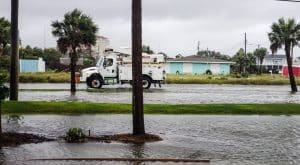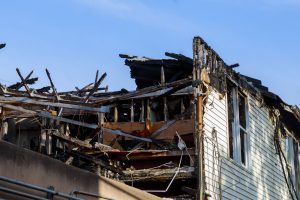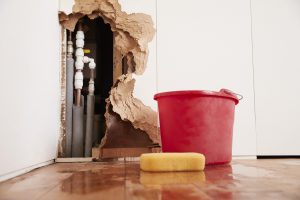We all know about the stress and devastation that come after a bad storm rolls through South Florida. While hurricane season is a way of life here, that doesn’t necessarily mean that residents should feel hopeless about keeping their homes safe. There’s plenty that can be done before, during, and after a hurricane to give your home the best chance for feeling like home again. Here at JASD Water, Mold And Fire Restoration Services, our decades of experience with hurricane remediation, water remediation, and mold remediation have prepared us to share tips for getting the best possible outcome when inevitable storms come. We consider your safety the first priority. However, there’s a lot you can do to protect your home without putting your safety at risk. Take a look at what South Florida residents need to know about hurricanes.
What Is Hurricane Remediation?
Hurricane remediation covers a wide range of services tied to making a home inhabitable again following a hurricane. The specifics of a remediation case can vary based on the severity of the storm. Remediation services often begin with an initial damage assessment. Next, the remediation team can offer:
- Moisture intrusion surveys.
- Testing for asbestos contamination.
- Evaluations for structural damage.
- Moisture mapping.
- Microbial assessments.
- Air-quality consulting.
- Management of contaminated waste.
- Response to chemical releases and spills.
- Subsurface investigations
- Utility restoration.
Hurricane remediation isn’t just about getting your home dry quickly. It’s about properly assessing the situation to ensure that risks are mitigated. While getting you back in your home as quickly as possible is always the goal, it’s also important to take the time to address moisture and contamination issues to preserve the long-term health of your household.
Before the Hurricane
Maintaining a safe environment in your home before a hurricane is one of the best ways to ensure that you don’t encounter unnecessary risks during the remediation process. This can be as simple as not storing dangerous chemicals or contaminants in your home that could be disrupted during a storm event. It’s also helpful to know about asbestos, lead, or any other “high risk” materials in your home that would make approaching your home after a storm on your own especially dangerous.
Preparing Your Home
How do you prepare your home for a hurricane in South Florida? First, create an emergency supply of food and water that could sustain you in the event that you get trapped in your home for a few days without electricity. You should also have your home stocked with emergency medicine supplies. If you’re taking any medications, speak with your doctor about ensuring that your prescription is full before a storm even touches down.
It’s also wise to have some emergency power sources to help you see in the dark. This can be as simple as some flashlights. However, solar-powered string lights, emergency flares, or a generator are all items to consider. It’s also important to have several working fire extinguishers throughout your home. In a post-storm landscape, loose wires can create dangerous fire hazards. Finally, be sure to have any important documents tucked away in a secure spot. This includes your medical documents, passport, personal identification, and other essential items that you’ll need on hand if you need to evacuate following a storm. Finally, turn your refrigerator and freezer to their highest settings just before the storm approaches. This will help you to preserve any cold foods for a little bit longer if the power goes out.
Strengthening Your Home
There are some steps you can take to make your home stronger in a storm. While there’s nothing that can guarantee your home will remain untouched, these tips can help to prevent preventable damage. Complete this checklist:
- Clean your gutters. This simple step can prevent leaves, branches, and other debris from causing overflows that will harm your roof, siding, and foundation.
- Store valuables in waterproof containers.
- Consider having a sump pump installed if your property is prone to pooling water.
- Close and lock all your windows to avoid vulnerable points. If necessary, reseal doors and windows that don’t close tightly.
- Consider shuttering windows to protect your home against flying debris.
- Install deadbolts to prevent strong winds from seeping in through doors.
- Repair or replace any compromised shingles or tiles on your roof. Consider having metal roof straps installed.
- Bring in all patio furniture and lawn decor. These items can all crash through windows if winds get strong enough. Do a check around your yard to remove anything that isn’t fully secured to the ground.
- Upgrade to vertical door braces.
Consider having an expert come out to give your home a hurricane grade before the next storm season. We can’t always detect vulnerable spots in our homes until we actually live through a storm. However, a seasoned professional will be able to spot potential problems that can be fixed to create a more secure place to ride out a storm.
Stocking Up on Supplies
As mentioned earlier, it’s important to have a food stockpile that can last for up to a week ready to go in a storm. This stockpile should consist of nonperishable food items that don’t require refrigeration. In addition, have enough bottled water on hand to sustain your entire household for up to a week. Keep your first-aid kit fully updated with medicine, antibacterial ointments, tweezers, gauze, and bandages.
During the Hurricane
First, follow all state and local guidelines for storm preparation. This includes evacuation alerts! While not every storm will require an evacuation, it’s important to always be prepared to leave at a moment’s notice. Have anything that you would need to bring along during an evacuation scenario already packed before the storm hits. In addition, you should have your evacuation route mapped out before the storm.
Staying Safe
How can you stay safe in your home during a hurricane if you aren’t advised to evacuate? It’s important to find a safe zone within your home where you can ride out the storm with as little risk of being injured as possible. Ideally, this is a location that is free of any windows. Stay on the floor during the storm’s impact to avoid being hit by any flying debris that could breach windows or doors.
Protecting Your Home
Fortifying your home against hurricane damage is important. However, no home is worth risking your personal safety. During a hurricane, the priority is always staying sheltered. Do not attempt to exit your home during a storm to make any repairs. You should also prioritize evacuating your home over staying to “watch over” your home.
After the Hurricane
It’s important to act with caution following a hurricane. Even damage that appears superficial can put your safety at risk if certain elements begin to flake off, fall, or collapse. Avoid touching any broken windows, loose shingles, or structural issues until you can have an expert come out to assess the damage. If water is inside your home, it’s important to avoid making contact with sitting water because it can be filled with harmful bacteria.
Take pictures of any damage for documentation purposes. Make note of any smells or visible signs of mildew and mold. If you will be entering your home to assess damage, be sure to wear protective gloves and clothing.
Cleaning Up
The priority after a hurricane is always removing water from your home. The truth is that the damage increases with every minute that water is allowed to sit inside your home. In addition to destroying furniture, electronics, flooring, and drywall in your home, sitting water can also create serious mold issues that threaten the health of your household. True cleanup can’t begin until you’ve brought in hurricane remediation specialists to use professional-grade vacuums and pumps to remove water.
Making Repairs
The repair phase can begin once water has been removed from your home. Be prepared for the fact that flooring that has been left submerged in water for any length of time may need to be replaced. However, determining a home’s overall structural integrity following a storm is something that must be done by professionals. The truth is that attempting DIY fixes for storm damage could be dangerous. You may also be simply putting a bandage over a serious structural issue that demands an intensive home restoration.
Get Help for Storm Damage in South Florida
JASD Water, Mold And Fire Restoration Services has been helping our clients bring their homes back from water damage for several decades right here in South Florida. In addition to repairing homes following flood damage, we also specialize in making homes safe and healthy again using mold removal services. Your personal safety is always the priority when a storm is coming. No home is ever worth the danger of trying to make repairs during a storm. That’s why we want you to know that we’re here to take care of storm damage after the storm has passed. Only trust your home with the best when you need help with storm damage in South Florida. Contact JASD Water, Mold And Fire Restoration Services today!



